Growing and Cooking Amaranth Greens
May 23, 2022 | Updated May 24, 2025
As an Amazon Associate I earn from qualifying purchases.
Amaranth greens, a/k/a pigweed, are some of the most nutritious leafy greens you can eat. Amaranth leaves are eaten all over the world, from India to Southeast Asia, Greece to Mexico. Here’s how to harvest and cook them.
Before we get too far, this article is not about amaranth grain, commonly known as quinoa. Those are amaranth seeds, the topic of another post.
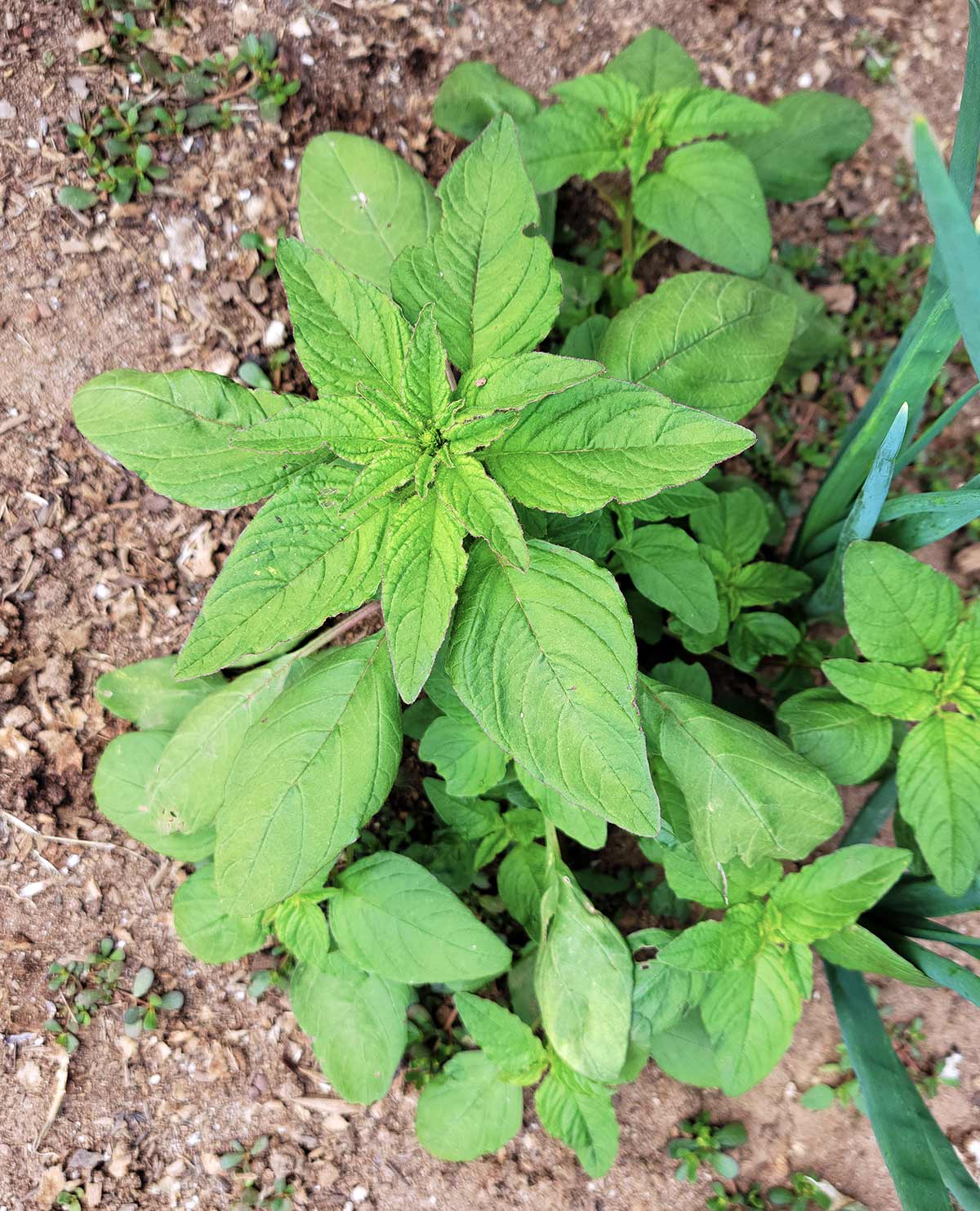
A Global Green
Amaranth greens show up in lots of cuisines, under many names. Quintonil in Mexico, they are one of that nation’s most important quelites, or wild greens.
In Greece, where vlita is an important horta, their word for wild greens, you’ll find amaranth leaves in pies, stews and warm salads. In India, amaranth falls under the saag moniker, a common meal of cooked greens. Saag paneer is the classic dish.
The famous callaloo of the Caribbean can be made with amaranth, too, although several greens can be used for that dish.
Here’s a cool one: Amaranth and lambsquarters are believed to be foundational plants in the development of agriculture here in the United States by the Eastern indigenous groups, several thousand years ago.
More recently, we in the United States know amaranth as pigweed, and it has a long tradition in country kitchens, along with pokeweed shoots and other local greens.
Growing Amaranth Greens
Chances are they are already growing in your yard or garden. I’ve written about edible weeds that likely live in your yard, and amaranth, or pigweed, is one of the most common.
Redroot or common pigweed, A. retroflexus, appears magically in my garden beds. Thanks, birds. I’ve also grown a pretty dark red amaranth for greens (reds?) and seeds, and it has naturalized in my yard as well.
Because many cultures like to grow and eat amaranth leaves, you can buy seeds of various varieties easily. Some of my favorites include red and white leaf amaranth from True Leaf Market., and Native Seed Search in Arizona has an entire selection of amaranth seeds for sale.
Many other seed companies sell them, too.
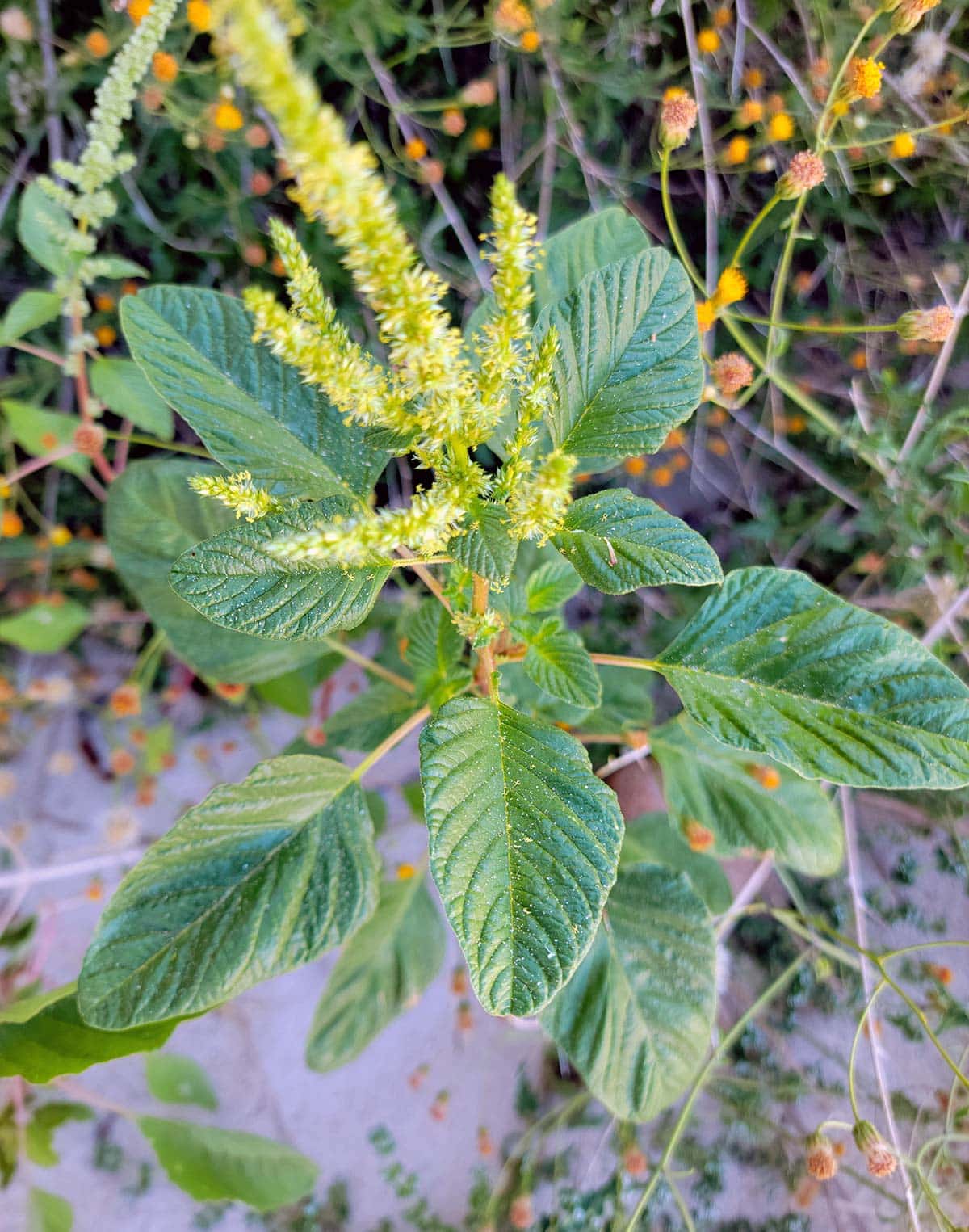
Amaranth is a warm weather plant, so it will appear well after the last frost as the soil warms. It has no problem with 100-degree days, and can seemingly grow inches a day when it’s hot out.
Amaranth has no real needs in terms of soil. I’ve seen it growing in beach sand and sidewalk cracks in Mexico, in a gravel parking lot, along roadsides, in old construction sites, and yes, in pretty, manicured garden beds, too.
Water it once in a while, if you feel like it. Amaranth is super drought tolerant, and sends a taproot to China. The plants are best spaced about a foot apart. They’ll grow closer, but the leaves won’t be as lush.
Keep in mind that if you want to harvest amaranth greens, you need to watch the plants. Amaranth wants to create an often showy and gigantic seed head — amaranth as a grain are those seeds — and once it gets going on that, the leaves suffer.
If you want to harvest amaranth leaves all summer, it’s not a bad idea to plant it several times, a month apart, from May to September.
Nutrition
Amaranth leaves are a powerhouse of nutrients. One recent study compared amaranth with spinach and chard, and the results were stark: pound for pound, amaranth greens have more protein than spinach (a lot more than chard), almost twice as much Vitamin C, and more fat, carbs, calcium and iron than the other two leafy greens.
Lambsquarters are close in nutrition; they are higher in protein and calories than amaranth, but amaranth leaves contain more potassium and iron than lambsquarters.
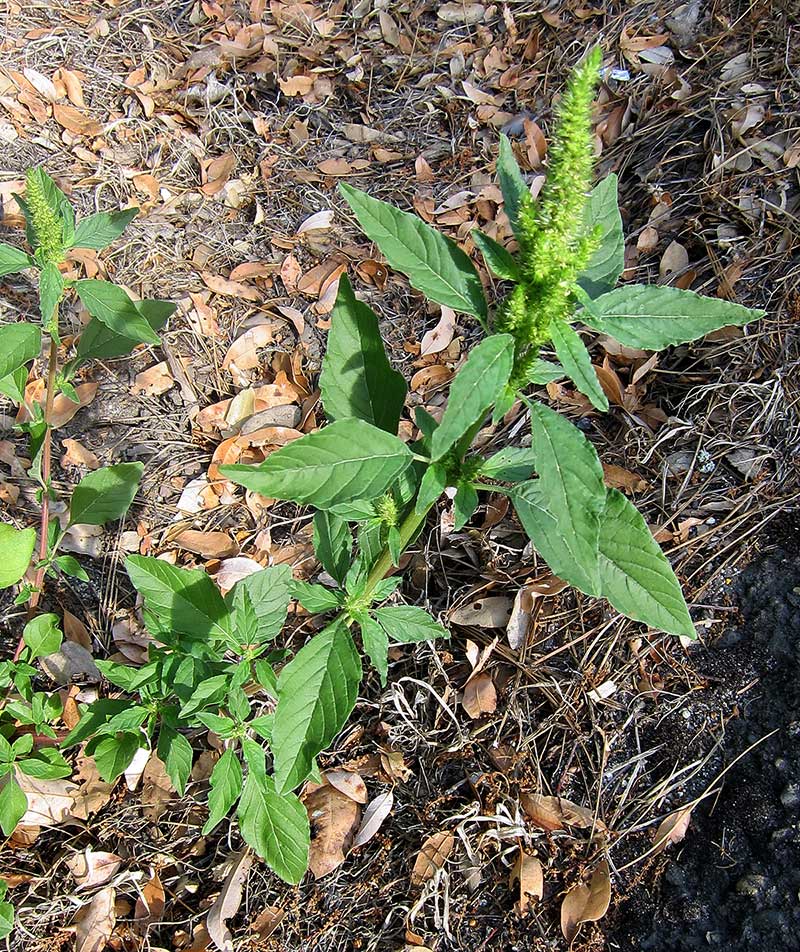
Harvesting
I generally harvest amaranth leaves off a whole plant. I let certain plants live until they get big — remember they are a weed all over my yard — and just as they start setting their seed heads, I pull the whole plant.
I strip all the leaves off the stems, discarding the baby seed heads, which are prickly. The leaves will keep in a plastic bag in the fridge for a week or so.
You can also just remove main stems of amaranth plants to harvest the leaves. The downside to that is that when you remove big stems, the plant tends to switch gears and start setting seed.
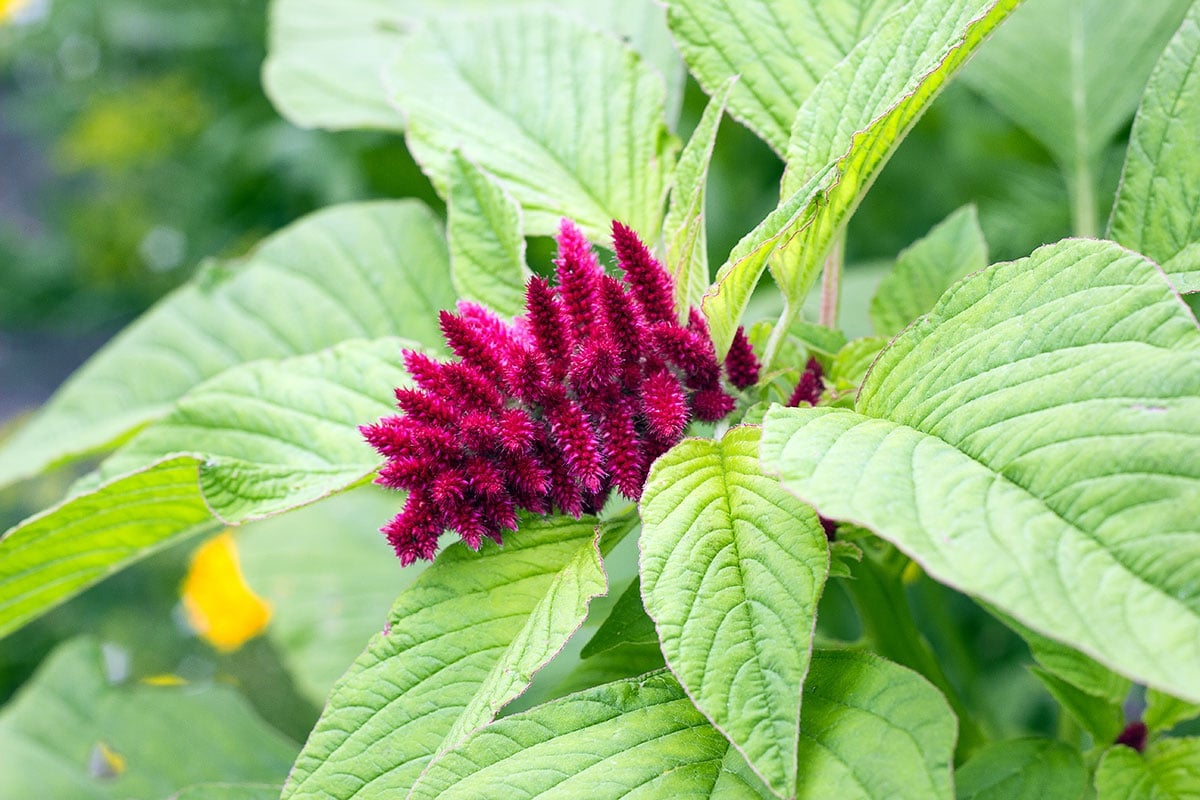
Cooking Amaranth Greens
The most common, basic and wonderful recipe for amaranth leaves, or really any leafy green, is this: Heat some oil, add a chopped onion and some garlic, salt, the greens, stir-fry to wilt them, add some sort of chile, then a little acid (citrus or vinegar) and black pepper at the end.
That’s it. That’s the best way to enjoy amaranth greens as they are.
If you make them this way, amaranth leaves are great stuffed in a tortilla with cheese as a quesadilla, stewed with pork instead of purslane, or tossed with pasta or served over polenta.
There’s a lot more to cooking amaranth leaves than that, if you want to explore. Here are some good options:
- Cook the greens, chop and then use in these Italian spinach dumplings.
- Same deal, although you’ll need to puree the cooked amaranth greens, if you want to make green spaetzle.
- Make some Indian saag paneer.
- Use amaranth greens in place of collards, with a ham hock and a jalapeno.
- Use them in place of spinach, chard, kale or turnip greens in really any recipe.
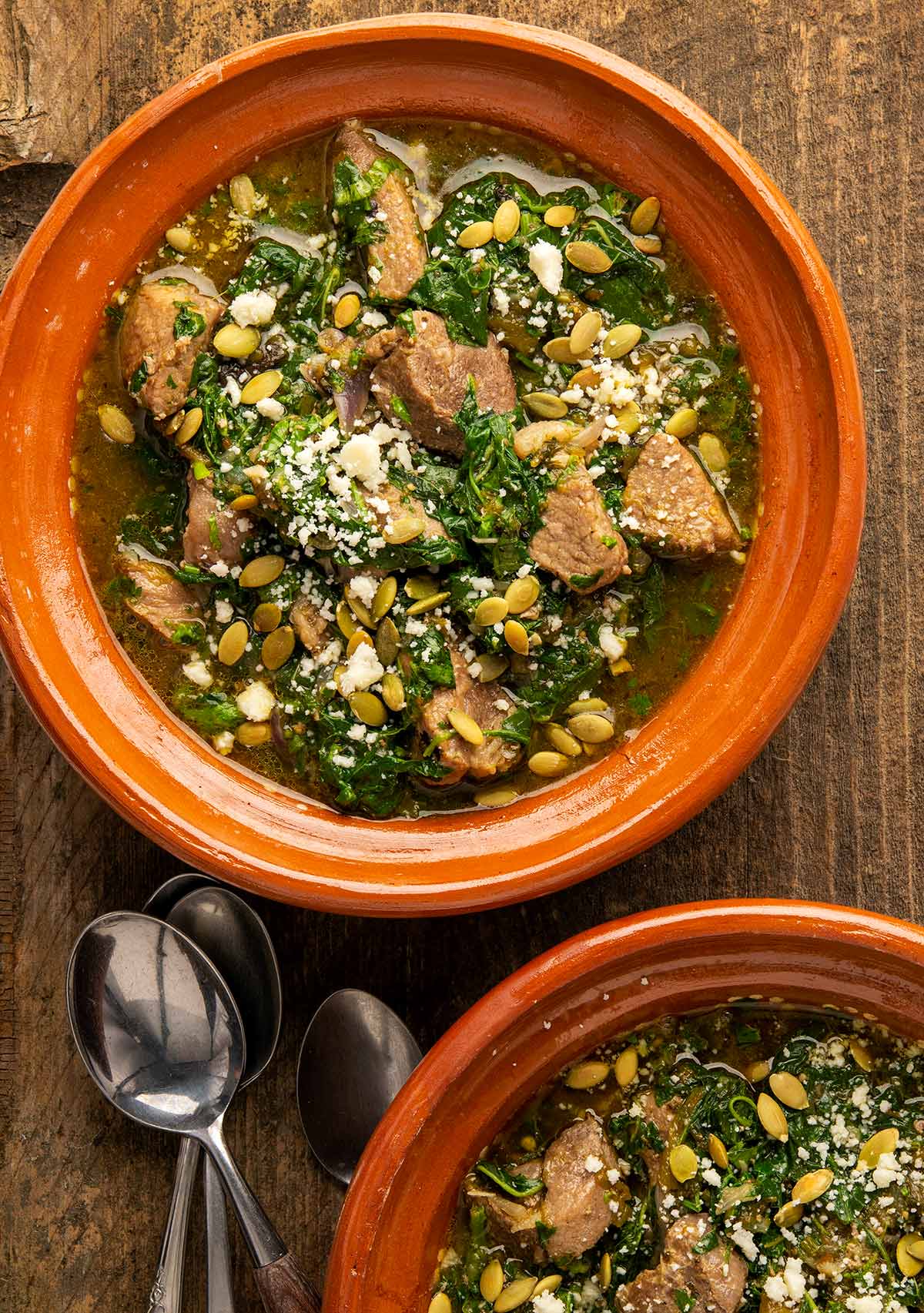
Preserving Amaranth Leaves
I normally just cook and eat amaranth greens. They’re all over, and the season lasts a long time. That said, if I want to preserve some for winter, I will boil them in very salty water for about 1 to 3 minutes, then shock the leaves in a big bowl of ice water.
Squeeze the excess water out of them and then vacuum seal them. Frozen, amaranth greens will keep about 6 months before they slowly discolor in the freezer.
Amaranth Greens with Pork
Ingredients
- 1 pound amaranth greens, or other leafy green
- Salt
- A pinch of baking soda
- 2 tablespoons olive oil
- 1 pound pork loin, cut into large dice
- 1 medium onion, sliced thin
- 2 serrano chiles, chopped (or 2 roasted Hatch or poblano peppers, chopped)
- 3 cloves garlic, minced
- 1 teaspoon Mexican oregano
- 1/4 pound tomatillos, chopped fine
- 1 cup stock or water
- 1/2 cup chopped cilantro
- Toasted pepitas or sunflower seeds, for garnish
Instructions
- Bring a large pot of water to a boil. Add the salt and the baking soda; the soda turns the water alkaline, and helps preserve the green color of the greens. It can make the water froth up, so leave some room between the water level and the top of the pot. Boil the amaranth greens for 2 minutes, then drain in a colander. Set aside.
- Heat the olive oil in a cazuela or really any large pot over medium-high heat. Brown the pork, salting it as it cooks, then add the onion and peppers. Cook until they are wilted, stirring occasionally. Stir in the garlic and cook another minute or two.
- Add the oregano, tomatillos and water or stock, mix well, and let this simmer. Add salt to taste. When the pork is tender and the liquid has cooked down a bit, maybe 15 to 20 minutes, add the cilantro and the amaranth greens, mix well, and cook 5 more minutes. Serve topped with pepitas and maybe some cotija cheese.
Nutrition
Nutrition information is automatically calculated, so should only be used as an approximation.




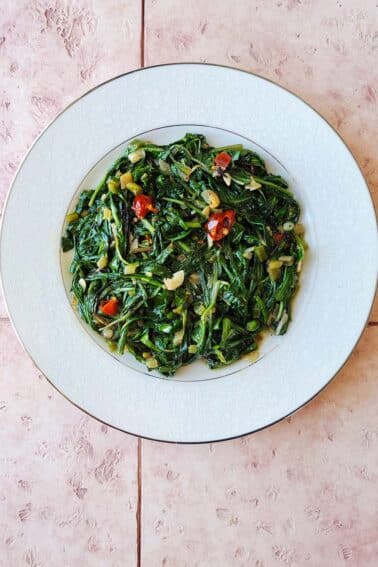

As far as preserving goes… weigh the greens, calculate 3% sea salt and make sauer-ama, by fermenting in the style of sauerkraut
Amaranth seeds are not the same as quinoa seeds. Quinoa is Chenopodium quinoa, whereas, amaranth is in the genus, Amaranthus, for example, Amaranthus cruentus.
This stuff invaded my herb garden. I was pulling and tossing it every week until today… I’m just going to let it grow and use it in lieu of kale during the summer. Maybe pair it with teal and galinule.
I just found you and I am anxious to try this recipe of Amaranth Greens with Pork. What do you think of me adding beans? Thank you
Irene: Go for it! Should be great.
I am Greek, so I have been eating Vleeta all my life. I live in the southern Maine Seacoast now and my mama sent me seeds from Greece, the very dark burgundy red variety, the kind that grow in Greece. For more then ten years now, they reseed themselves every year in our veggie garden. We eat them boiled and topped off with lemon, olive oil and salt. I used them in omelets, or sautéed with garlic and olive oil. Also accompanied by feta, a marriage made in Heaven. Everything you said is true, much better than spinach and not chalky taste that spinach has. You cannot describe the taste, to my it is heaven. Also make vleeta pita with them instead of spanakopita.
I appreciate that you bring about this simple yet nutritious green which people in SEA eat for ages. We often make summer soup: amaranth, cougret, ground beef, season with salt, pepper and garnish the bowl of soup with finger tip of cilantro and chive.
Thuy: Sounds really good, thanks for the idea!
Great info and I am now on the hunt. Maybe good in a Bierock. A friend mentioned he likes beet greens as well for that. Thanks
Thank you for post, it is a keeper. I would really appreciate your recommendation of an amaranth seed that has a decent greens taste. Many posts do mention a spinach taste, but one post from Baker Creek’s seed reviews mentioned a ‘Regret this choice’ review for the ‘Hopi red dye amaranth’ because of the leaf texture. Now I am considering looking at reviews for amaranth greens and have found none other than it tastes like spinach. Maybe that ‘Hopi red dye’ review was a fluke?
Do you know any books on growing amaranth or a facebook group? I live in California, zone 10b(?). I am a teacher and love to have a reference to return to on step by step gardening. Your post is pretty close though.
Thank you again.
PS Where do you buy your seeds?
Maria: I buy from lots of sources, but I really like Native Seeds Search for amaranth. Kitazawa has a good “greens” amaranth, too. White stem I think it’s called. Honestly, amaranth grows all around you naturally. It’s in your empty lots, waste places, parks, backyards, parking lots. Once you remember what it looks like, you’ll see it everywhere. I am in Sacramento, BTW.
I found this plant in my backyard so I decided to Seek to identify this plant. It said it was Amaranth. Is it possible to dig it up and plant it somewhere else?
Debby: Not sure. I’ve never tried it. But I bet if you dug up a small one it would work.
I have what appears to be purple amaranth in my garden. It’s supposed to be oregano. Excuse my ignorance, first time planting oregano. Are the two often confused? Are they one in the same?
John: They are very different.
Thanks for this very informative post. I’ve occasionally seen red amaranth leaves tossed into salads, but what do they taste like? Chard? Kale? Spinach? Collards? Beet greens?
Sharon: They’re closer to spinach than anything else.
Hank, you are very well versed. You are spot on with your reference to vlita. They are a true favorite for most Greeks. We prepare them simply. Steamed, drizzle with some good olive oil and lemon. Paired with a whole local rock cod and a nice glass of wine/ouzo. A summer meal that is hard to beat.
What birds / wildlife does it appeal to?
Gary: No idea! But little seed-eating birds do swarm the big seed heads in fall, so a bunch do like it.
I think I might have been mistaking these leaves for nightshade, dang!
First year growing Amaranth from the orient leaf is green and red haven’t tried any yet they are still only about 6 inch tall. can’t wait to try. live on Land River and Lake LBJ. so hot and humid this year all beans have leaf spot of some kind growing creole’s tomatoes wind avg 12 mi per hour every day. so their are not setting fruit Oh Well. trying to catch red ear sun fish and Gaspergoo. reg sunfish a plenty. any tips for the black and the silver drum. ?????? to catch em ??
Amaranth seed is kiwicha in South America, while quinoa is the seed of a Chenopodium (related to fat hen / goosefoot / lamb’s quarters) – perhaps that they’re both seeds of great foraged “weeds” threw you. I reckon plant thick (because collecting heaps of last year’s seeds is so easy) and pick young – when you can draw all but the earliest leaves up to a bunch at the top of the stem to pluck in one go. You tend to get a second crop just come through from the same sowing filling in the harvested space. We’d probably get half our year of cooked leafy greens from amaranth with perhaps 10% of our leafy green growing effort. Awesome stuff.